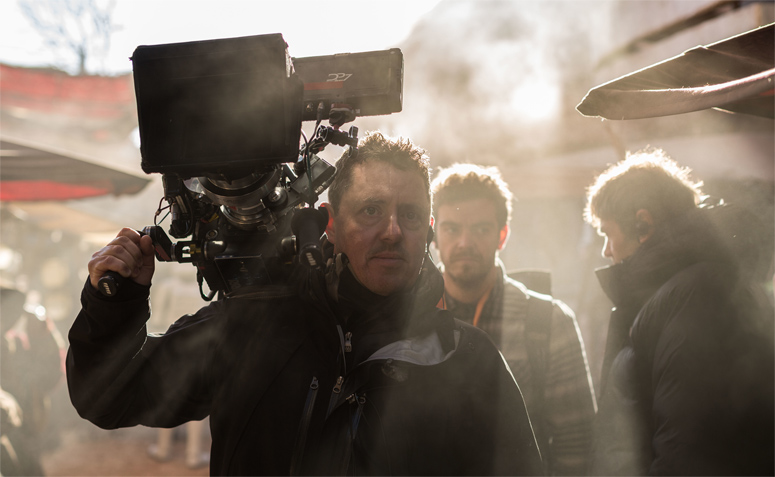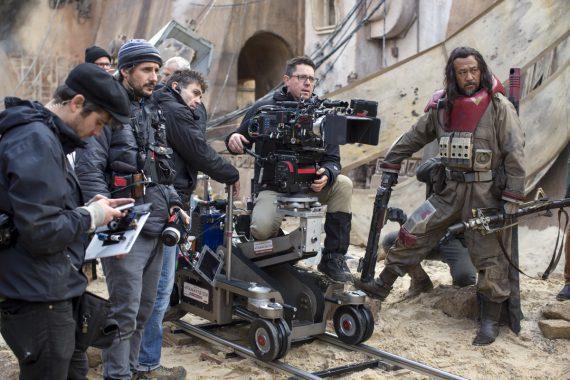
Greig Fraser, ASC, ACS Talks Creative Choices at AFI
The cinematographer discusses his creative approach to using the Alexa 65’s 6K sensor, lenses and LED lighting.
As part of the recent CamerImage screening event held at the American Film Institute, ASC Award-winning and Academy Award-nominated cinematographer Greig Fraser, ASC, ACS sat down to speak about his experiences with the Arri Alexa 65 and Digital Sputnik LED lighting.

On a sunny Sunday afternoon, a couple dozen students and professionals gathered in the Mark Goodson screening room at AFI, where former ASC president Stephen Lighthill, ASC sat down with Fraser to discuss his work.
“It’s been a little bit, but seeing this camera is like seeing an old friend,” Fraser offered on the Alexa 65. “I’ve shot about 200 days with it in the last 12 or 13 months.”
After a series of short films, documentaries and independent features, Fraser burst onto the cinematography scene with his graceful and subtle photography of Let Me In, the American remake of the Sweedish vampire film Let the Right One In. Fraser followed that with Snow White and the Huntsman, Killing Them Softly, Zero Dark Thirty, Foxcatcher, Rogue One: A Star Wars Story and this year he won the ASC Award and was nominated for the Academy Award for Lion. Although Lion was photographed with the Arri Alexa, both Rogue One and Fraser’s upcoming Mary Magdalene were shot with the Alexa 65.

“I’m always cautious about advertising products or companies,” Fraser warns. “We, as artists and craftsman rely on these things to enhance our art and I want to make sure that when I’m discussing a particular product that it’s only in context to a specific project. There are many different tools for a project and as cinematographers we need more tools. The more tools the better. This gives us more choices and more control over our images.
“This camera is the closest thing to my still photography that I’ve ever seen,” Fraser continues. “I used to be stills photographer, and I joined the motion picture rebellion when I was 20, shooting 35mm. I always felt ripped off by the size of the negative! It’s not 35mm, it’s like half 35mm!” the cinematographer laments, referring to the difference in orientation between 35mm still film and 35mm motion picture film. “When Arri showed me the [Alexa 65], I took the portcap off and thought ‘That’s the biggest sensor I’ve seen outside of a medium-format camera.’ The possibilities over the 35mm format are incredible. It’s also key to know that you don’t have to use the whole sensor, you can crop it and only use part of it. It’s a 6K sensor, so there’s room to use only a bit of it and still have plenty of resolution left for your project. For Mary Magdalene, for the first part of the film, we used a small part of the sensor, 35mm lenses, and cropped it to about 3.8K – 4K. Then there was a point in the movie where that changes — the screen doesn’t change, the aspect ratio doesn’t change — but we open up to the full 6.5K sensor and it changes the feel of the whole image. It’s amazing depth of field and lens quality and lens falloff that I’ve never seen in 35mm. I’m a big fan of the sensor size.”
Fraser first screened a Nike commercial he had shot with the Alexa 65. The spot features Kobe Bryant on the basketball court who is booed by anti-fans who scream out hatred at him. Kobe turns to the crowd, the lights dim putting him in a spotlight and he begins to act like a conductor directing certain voices of hatred towards him into a literal symphony of vile. Fraser followed this with test footage for the independent film he just completed shooting, Mary Magdalene. The footage featured crew members in a twilight exterior with various exposure and lens choices.
After screening the footage, the cinematographer took the crowd out to the lobby where an Alexa 65 was set up on a Fisher dolly and some lighting, featuring the Digital Sputniks. With the help of an actress, Fraser proceeded to tweak some lighting and swap out lenses to demonstrate the looks from each lens. The room was deep standing room only with a few monitors placed about to see the work in progress. Fraser’s quiet persona forced silence in the room as the students hung on his every word. Fraser also demonstrated several lens choices from Arri, including the Series S Primes and new DNA lenses, along with Hawk 1.3 anamorphics from Vantage Film.
After shooting, the audience returned to the theater as AFI students ingested the footage into the 2K projector and then they screened the footage with Fraser narrating.
“I love the fastest possible lenses,” the cinematographer offered. “You want the ability to have the focus fall off, but that might be too extreme, so you close down the stop. It’s an aesthetic choice. Mary Magdalene was shot almost entirely at a T4. The director and I decided that was what we were after. On Rogue One, however, everything was a T2 2/3, with a couple lenses at a T2.8 because that’s where those specific lenses performed better for us. You just have to understand the individual characteristics of the lenses you’re working with and work with them.”
Following the second discussion, Fraser took the crowd downstairs in the Louis B. Mayer building into a classroom where another lighting setup and actress awaited. Here it was very low light conditions with the Digital Sputniks and, again, Fraser went through various lenses and shoot footage.
“Mary Magdalene is a fairly low-budget movie shot in Italy.” Fraser explained. “We didn’t have many lights with us at all, I basically only took the Digital Sputniks, which I used for daylight, moonlight, fire, pretty much everything. We only ran off small generators, didn’t need any big cable runs, which cut down on the crew. The producers had $10,000 in the budget for consumables, but I said we don’t need gels with the Digital Sputniks, so let’s keep $2,000 of that for diffusion and put the remaining $8,000 back into camera. With LEDs, we used hundreds of RGB LEDs on Rogue One and at a push of a button we could change the entire color of a set; that is amazing. For me the appeal of RGB LED, though, is not the primary colors, it’s the skintones and the subtle colors.”
The group returned, once again, to the theater where Fraser commented on the new footage.
“We as cinematographers need to take back our choices,” Fraser concluded. “Camera companies and lighting companies and lens companies coming up with really interesting formats give us choice back. I recall when there were three film manufacturers: Agfa, Fuji and Kodak. When I was thinking about a music video 20 years ago, I had about 40 film choices at that point. As companies closed down, I might have had 12 film choices. Right now, I have four choices. Our choices are being eroded because of the way that technology is going. In some ways, you can say that digital has allowed us to democratize filmmaking; and in some ways it has also killed us because we have less choices. So anything we can do to take that choice back, is great. These tools like the Alexa and Digital Sputniks just expand the cinematographer’s toolbox to give the choice back.”






